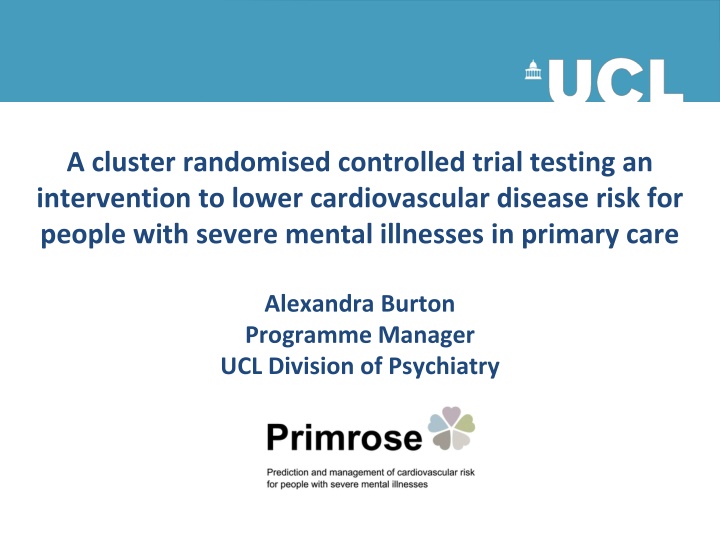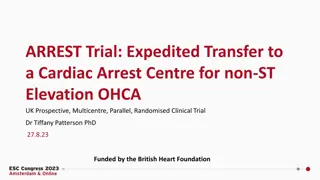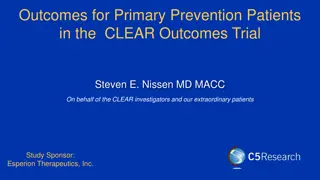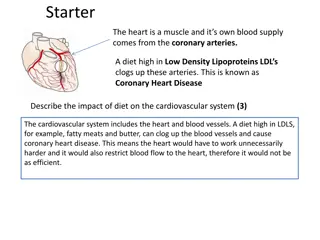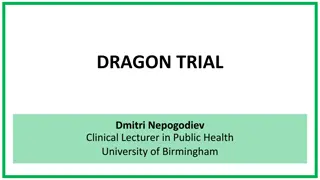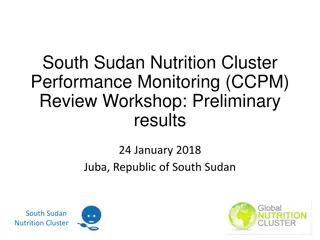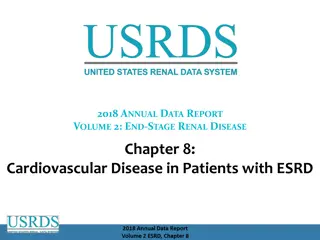Cluster Randomised Controlled Trial for Cardiovascular Disease Risk in Severe Mental Illness
A cluster randomised controlled trial is being conducted to test an intervention aimed at reducing cardiovascular disease risk for individuals with severe mental illnesses in primary care settings. Led by Professor David Osborn at UCL Division of Psychiatry, the study is funded by the National Institute for Health Research and sponsored by Camden and Islington NHS Foundation Trust. The research aims to address the heightened CVD risk faced by those with schizophrenia or bipolar disorder, who often experience premature mortality due to various factors such as lifestyle difficulties, stress, and suboptimal management of CVD risk. By focusing on primary care, where responsibility for physical health lies, this initiative seeks to close the mortality gap and improve outcomes for individuals with severe mental illnesses.
Download Presentation

Please find below an Image/Link to download the presentation.
The content on the website is provided AS IS for your information and personal use only. It may not be sold, licensed, or shared on other websites without obtaining consent from the author.If you encounter any issues during the download, it is possible that the publisher has removed the file from their server.
You are allowed to download the files provided on this website for personal or commercial use, subject to the condition that they are used lawfully. All files are the property of their respective owners.
The content on the website is provided AS IS for your information and personal use only. It may not be sold, licensed, or shared on other websites without obtaining consent from the author.
E N D
Presentation Transcript
A cluster randomised controlled trial testing an intervention to lower cardiovascular disease risk for people with severe mental illnesses in primary care Alexandra Burton Programme Manager UCL Division of Psychiatry
Background Chief Investigator: Professor David Osborn (UCL Division of Psychiatry) Funder: National Institute for Health Research Sponsor: Camden and Islington NHS Foundation Trust Delivery: PRIMENT and the NIHR CRN Collaborators: UCL Depts of Primary Care and Pop Health, Statistical Science and Centre of Applied Health Research, McPin Foundation, Rethink Mental Illness, University of Southampton, Kings College London, Imperial College London Imperial College London Camden Islington NHS Foundation Trust
Background Increased risk of cardiovascular disease (CVD) and mortality in people with schizophrenia or bipolar: o Die up to 20 years earlier than the general population o Those under 50 with these conditions are more than 3 times at risk of CVD than their contemporaries o The mortality gap is increasing Why? Difficulties managing lifestyle, stress, poverty Illness factors and antipsychotic medications Diagnostic overshadowing and sub optimal management of CVD risk
Why primary care? NICE places the responsibility for physical health of people with SMI in primary care Not all people with SMI are accessing secondary services The Quality Outcomes Framework (QoF) incentivises annual physical health checks for people with SMI Effectiveness of practice nurse management of long term conditions diabetes, asthma, CVD
Overview of the Primrose Programme Five year National Institute for Health Research (NIHR) Programme Grant with three main work packages: 1. Develop a new tool to better predict cardiovascular disease (CVD) risk in people with severe mental illnesses (SMI): https://www.ucl.ac.uk/primrose-risk-score/ 2. Identify the best available evidence and develop an intervention and training package for GP practice nurses and healthcare assistants to help lower CVD risk in people with SMI. 3. Test the clinical and cost effectiveness of the intervention and training package in a 12-month cluster RCT delivered in GP Practices
Overview of the Primrose Trial Aim: To test the effectiveness and cost effectiveness of a practice nurse/healthcare assistant led service to reduce cholesterol and CVD risk in people with SMI. Method: 12-month pragmatic cluster RCT coordinated in 6 recruitment waves Intervention: Primrose intervention + British Heart Foundation (BHF) leaflets vs treatment as usual (TaU) + BHF leaflets Primary outcome: Total cholesterol at 12 month follow up Secondary outcomes: BMI, HBA1c, waist circumference, blood pressure, CVD risk scores, diet, physical activity, smoking, alcohol use, medication adherence, statin prescriptions, wellbeing, service use and costs Data Collection: Baseline, 6 and 12 month by research nurses in clinical research networks (CRNs)
Overview of the Primrose Trial GP Practice inclusion criteria: SMI register list of >40 patients Resources to deliver the intervention if randomised (practice nurse/HCA) Patient inclusion criteria: SMI (schizophrenia, bipolar, psychosis) 30-75 years old Cholesterol above and including 5 mmol/l and/or total/HDL chol ratio above and including 4 mmol/l and one or more of the following: BMI > 30 kg/m2 Blood pressure above 140mm Hg systolic and/or 90 mm Hg diastolic Current smoker HbA1c 42-47 mmol/ml Diabetes Hypertension
Overview of the Primrose Trial Patient exclusion criteria: Under acute psychiatric care Primary diagnosis of organic mental health problem and/or severe cognitive impairment Life expectancy < 6 months Pre-existing CVD Currently pregnant Personality disorder or depression/anxiety without any psychotic features
PRIMROSE Study Overview 1. Invite all people with SMI for CVD screening Randomisation of practices PRIMROSE ARM TREATMENT AS USUAL ARM Use behaviour change techniques to promote adherence to medication and change unhealthy lifestylebehaviours Manage referrals to services and organise prescriptions. 2. CVD screening Practice Nurse/Healthcare Assistant Responsibilities a) Blood test for lipid and glucose profiles, blood pressure, weight, height, BMI, smoking status, alcohol screen b) Record initial consent from each patient 3. Review results of screening and identify eligible patients Research nurse arranges initial consent and baseline assessment meetings Informed consent and baseline appointment with research nurse Researcher/Research Nurse Responsibilities 19 General Practices 10 participants each =190 19 General Practices 10 participants each = 190 Attend two days training Arrange 8-12 appointments over 6 months Send basic best practice information Treatment as usual over 6 months PRIMROSE training received at end of trial 6 month follow-up interview with researcher/research nurse 12month follow-up interview with researcher/research nurse
What is the Primrose Intervention? 8-12 appointments with a practice nurse or healthcare assistant in the patient s GP practice over 6 months Support patients to change behaviour by identifying and monitoring goals to improve cardiovascular health e.g. taking medication, stopping smoking, improving diet, increasing physical activity or reducing drinking Refer on to existing support services and/or Brief behavioural support provided directly Follow-up and monitoring including attendance at services and progress with health goals
What is the Primrose Intervention? Two day training programme delivered by a health psychologist and practice nurse with mental health expertise Two week gap between training sessions for nurses/HCAs to practice intervention delivery with a patient Study manual detailing procedures, appointment structures and behaviour change strategies to use within appointments
Recruitment and follow up 327 patients and 76 GP practices recruited to the study across the UK 289/327 (88%) patients followed up at 12 months 155 patients randomised to receive the intervention and 172 patients randomised to receive routine care Average cluster size: 4.3 patients
Figure 1. Primrose Study CONSORT Flow Diagram Enrollment GP Practices invited to take part (N= 133) Excluded (N= 44) Not interested (N=24) Unable to support the study (N=10) Not enough patients to approach (N=10) Excluded (N= 13) No longer interested (N=1) Loss of resources to support the study (N=2) Not enough patients to approach (N=1) Unable to recruit (N= 9) GP Practices recruited (N= 89) Excluded (n= 3091) Not contactable (n=2271) Declined to participate (n=792) Other reasons (n=28, Unwell(n = 9), Declined blood test (n = 1), Moving practice (n = 4), Out of the country (n = 1), Too busy (n = 1), Unable to speakEnglish (n = 1), GP excluded(n = 11) Patients invited to take part (n= 3982) Patients screened for eligibility (n=891) Excluded (n=564) Not meeting inclusion criteria (n= 363) Declined to participate (n= 196) Other reasons (n=5, Unwell(n=1), Moved out of area (n =2), Not contactable(n =2) GP practices randomized (N= 76) Patients allocated (n= 327) Allocation Allocated to TAU Number of GP Practices = 38 Number of patients =172 Allocated to intervention plus TAU Number of GP Practices = 38 Number of patients =155 Received allocated intervention (n= 123) Did not receive allocated intervention (give reasons) (n= 32 Death = 1, Not contactable = 18, Too unwell = 3, Full time employment = 1,Not contacted = 6, Patient left practice = 3) 12 Month Follow-Up Lost to follow-up Number of GP Practices = 0 Number of patients = 18 (Death= 1 Withdrew = 10 Not contactable = 5, Too unwell = 1, Bloods missing = 1) Lost to follow-up Number of GP Practices = 0 Number of patients = 19 (Death = 3, Withdrew = 5 Not contactable = 4, Hospitalised = 3, bloods missing = 3, Moved out of area =1) Analysis Analysed (GP Practices = 38, patients = 137) Excluded from analysis = 0 Analysed (GP Practices = 38, patients = 152) 1 patient excluded from analysis (not eligible for the study)
Primrose Study Sample Primrose n/N or mean % or (SD) 67/155 51 Variable TAU n/N or mean % or (SD) 43 87/171 51 Male Age Ethnicity (10) 51 (10) 134/154 11/154 5/154 4/154 87 155/171 5/171 5/171 6/171 91 White Black Asian Other 7 3 3 3 3 4 Townsend quintile 1 least deprived 2 3 4 5 most deprived Primary diagnosis Schizophrenia/ schizoaffective Bipolar Other psychoses 22/136 7/136 17/136 30/136 60/136 16 17/119 11/119 11/119 28/119 52/119 14 5 9 9 13 22 44 24 44 54/155 35 51/171 30 71/155 30/155 46 19 88/171 32/171 51 19
Headline results Total cholesterol decreased in both Primrose intervention and treatment as usual groups with no significant difference between groups (5.4 mmol/L [SD 1.1] vs 5.5 mmol/L [1.1]; mean difference estimate 0.03, 95% CI 0.22 to 0.29; p=0.788). No significant differences in secondary outcomes Adjusted intra cluster correlation (ICC) = 0.07 Effects differed more than we expected between practices
Results by randomised group Baseline 12 months Coefficient 95% CI Variable Primrose n/N or Mean (% or SD) 5.7 (0.9) TAU Primrose n/N or Mean (% or SD) 5.4 (1.1) TAU n/N or Mean (% or SD) 5.9 (1.0) n/N or Mean (% or SD) 5.5 (1.1) 0.03 -0.22, 0.29 Total (mmol/L) HDL cholesterol Total/HDL cholesterol HBA1c Systolic Diastolic Body mass index Waist circumference AUDIT score Current smoker cholesterol 1.3 (0.4) 4.8 (1.4) 1.3 (0.4) 4.9 (2.1) 1.3 (0.5) 4.5 (1.4) 1.3 (0.4) 4.4 (1.3) -0.01 0.13 -0/07, 0.05 -0.16, 0.42 41 (11) 127 (17) 82 (11) 32 (6) 107 (16) 2 (0, 7) 80/155(52%) 80/171(47%) 39 (8) 129 (19) 82 (11) 32 (6) 108 (15) 3 (0, 7) 41 (11) 125 (16) 80 (10) 32 (7) 106 (16) 2 (0, 5) 62/134(46%) 40 (9) 126 (17) 80 (0,7) 32 (7) 107 (15) 3 (0, 7) 68/155(44%) 0.14 -0.97 0.56 -0.44 -0.55 -0.51 0.79 -1.36, 1.65 -4.34, 2.40 -1.69, 2.81 -1.18, 0.30 -2.33, 1.23 -1.45, 0.42 0.36, 1.70
Headline results Overall costs were lower in Primrose vs TaU ( 1286 [SE 178] vs 2182 [328]; mean difference 895 ( 1631 to 160); p=0 012) Lower psychiatric admission costs in Primrose vs TaU ( 157 [135] vs 956 [313]; 799 ( 1480 to 117); p=0 018).
Health care service costs by category of health care resource use at baseline and 12 months Difference b/w Primrose and TAU (baseline adjusted) Baseline 12 months Primrose TAU Primrose TAU Mean (SD) Mean (SD) Mean (SD) Mean (SD) Mean 95% CI 177 (158) 172 (132) 143 (139) 133 (140) 5 (-26 to 35) GP 34 (47) 31 ( 70) 54 (65) 28 (61) 24 (9 to 39) Primary Care Nurse HCA 18 (23) 15 (28) 36 (51) 13 (35) 21 (7 to 34) 241 (393) 267 (435) 182 (279) 287 (530) - 98 (-205 to 10) Community mental health 48 (138) 35 (100) 39 (88) 32 (82) 6 (-13 to 26) A&E Outpatient (physical health) Outpatient (mental health) 305 (557) 296 (628) 471 (848) 407 (688) 63 (-126 to 251) 193 (384) 238 (541) 158 (344) 177 (419) - 9 (-119 to 99) 117 (611) 186 (1327) 80 (448) 310 (1663) - 182 (-427 to 63) Inpatient (physical health) 972 (5983) 853 (3847) 163 (1485) 950 (4262) - 799 (-1480 to -117) Inpatient (mental health) 2142 (6248) 23 (78) 1209 (3261) 2126 (4474) 12 (35) 1293 (1997) 24 (80) 1215 (2279) 2176 (4388) 15 (42) 1048 (1508) - 895 (-1631 to -160) Total Service Cost Statin costs - 2 (-10 to 6) 848 (1099) - 18 (-389 to 353) Medication
Strengths and limitations Pragmatic trial GP practices across rural and urban practices BUT all participants received CVD screening pre-baseline/ randomisation Inclusion criteria and choice of outcome? Small number of participants per practice Lack of focus on statins
Conclusions The Primrose intervention was not effective over and above routine GP practice care at reducing CVD risk factors in people with SMI ?Good care in the treatment as usual group; short duration of intervention; low prescribing rates of statins, focus on diet and physical activity not statins in goal setting? There was evidence of reduced costs and reduced psychiatric admissions in the Primrose arm. ?Regular contact with a HCP reducing the need for psychiatric service use but could also be a chance finding?
Trial outputs and social media 1. Osborn D, Burton A, Walters K, Nazareth I, Heinkel S, Atkins L, et al. Evaluating the clinical and cost effectiveness of a behaviour change intervention for lowering cardiovascular disease risk for people with severe mental illnesses in primary care (PRIMROSE study): study protocol for a cluster randomised controlled trial. Trials. 2016;17:80. Epub 2016/02/13 2. Osborn DP, Burton A, Hunter R, Marston L, Atkins L, Barnes T, et al. Clinical and cost- effectiveness of an intervention for reducing cholesterol and cardiovascular risk for people with severe mental illness in English primary care: a cluster randomised controlled trial. Lancet Psychiatry 2018; 5:145 54. https://doi.org/10.1016/S2215-0366(18)30007-5 Website: www.ucl.ac.uk/Primrose : @UCLPrimrose
